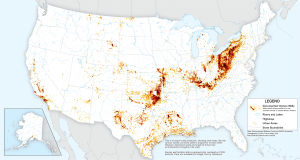 Last year, for the first time, EDF and McGill University mapped every existing documented orphan well across our country. Shortly after, Congress passed the Infrastructure and Investment Act, IIJA, which included $4.7 billion to document, plug and remediate orphan wells. This new funding, secured through EDF’s leadership, provides federal support for the first time for states, Tribes, and federal land management agencies to find and plug orphan oil and gas wells that are inactive and unplugged with no solvent owner of record.
Last year, for the first time, EDF and McGill University mapped every existing documented orphan well across our country. Shortly after, Congress passed the Infrastructure and Investment Act, IIJA, which included $4.7 billion to document, plug and remediate orphan wells. This new funding, secured through EDF’s leadership, provides federal support for the first time for states, Tribes, and federal land management agencies to find and plug orphan oil and gas wells that are inactive and unplugged with no solvent owner of record.
Prior to this legislation, states, which oversee 90% of the wells in the country, had a fraction of the funding needed to plug wells with the unfortunate result that they often sat unplugged for decades. Now, we’re publishing an updated orphan wells map that draws on newly available data to offer decision makers and the public a clearer picture of the issue.














